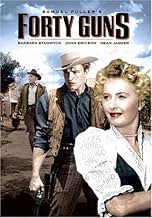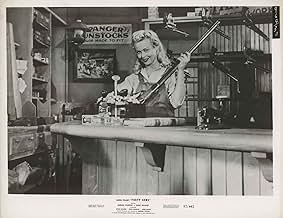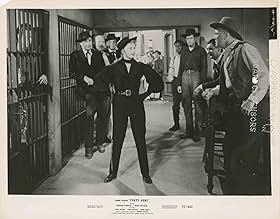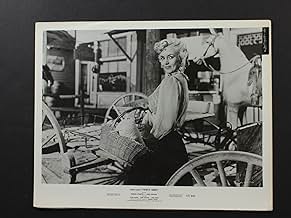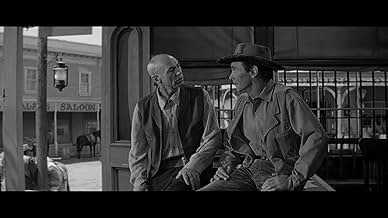VALUTAZIONE IMDb
6,9/10
6874
LA TUA VALUTAZIONE
Scontro in Arizona tra i fratelli Bonell - gli agenti federali - e Jessica Drummond, la contadina dal pugno di ferro che controlla il territorio.Scontro in Arizona tra i fratelli Bonell - gli agenti federali - e Jessica Drummond, la contadina dal pugno di ferro che controlla il territorio.Scontro in Arizona tra i fratelli Bonell - gli agenti federali - e Jessica Drummond, la contadina dal pugno di ferro che controlla il territorio.
- Regia
- Sceneggiatura
- Star
Sandy Wirth
- Chico's Girlfriend
- (as Sandra Wirth)
Albert Cavens
- Doctor
- (non citato nei titoli originali)
Tex Driscoll
- Barber
- (non citato nei titoli originali)
Recensioni in evidenza
Barbara Stanwyck (hard as nails) plays a powerful rancher with political ties near Tombstone whose hired hands, mostly crooked and lead by her own brother, bring her together with Barry Sullivan of the U.S. Attorney General's office, out to arrest one of her boys for robbery. Surprisingly brutal and adult western from Globe Enterprises and distributed by Twentieth Century-Fox, written and directed by Samuel Fuller as if he were trying to find a place for every western cliché in the filmmaker's manual. Joseph Biroc's moody black-and-white cinematography gives the proceedings an intensity that elevates the script, even as Fuller's staging--particularly the gun-blazing confrontations--typically run the gamut from florid to outrageous. Sullivan is sturdy (and colorless) as usual; Stanwyck has this type of role down pat. **1/2 from ****
I often record films off TCM or other film channels and I'll nearly always record westerns. Often I don't get past the first few minutes but every now and then I come across a real classic. I wasn't aware of this film or its cult status when I watched it so I was able to form an opinion without a prior bias.
Firstly I was impressed by the opening scene of Barbara Stanwyck and her forty horsemen thundering across the screen and richness of the black and white cinematography. The film itself immediately grabbed my interest and the dialogue was at times cheesy, at times full of sexual innuendo, but always interesting. It was only when it came to a scene where the Bonnell brothers are walking through Tombstone that I realised I was watching a single shot that went on and on and on. There's no merit in doing long tracking shots just for the hell of it but this was something that worked beautifully.
The composition of many shots and their realisation was quite magnificent and I would love to see this on a big screen now. One scene where a widow is shot from below and there is a long pan past the hearse to a singer under a tree and back again puts most modern music videos to shame.
It has to be said that this is also one of the silliest and campest films ever made with its emphasis, not to mention song, on a "high riding woman with a whip". The general fondling of firearms and sexual references are so blatant that it seems surprising that this film wasn't universally condemned by the usual suspects on its release.
I was also impressed by the cast who weren't what you might expect for a western. I especially liked Barry Sullivan's pre-Leone, pre-Eastwood portrayal of the gunslinger.
All in all a complete delight. I'm looking forward to watching it again.
Firstly I was impressed by the opening scene of Barbara Stanwyck and her forty horsemen thundering across the screen and richness of the black and white cinematography. The film itself immediately grabbed my interest and the dialogue was at times cheesy, at times full of sexual innuendo, but always interesting. It was only when it came to a scene where the Bonnell brothers are walking through Tombstone that I realised I was watching a single shot that went on and on and on. There's no merit in doing long tracking shots just for the hell of it but this was something that worked beautifully.
The composition of many shots and their realisation was quite magnificent and I would love to see this on a big screen now. One scene where a widow is shot from below and there is a long pan past the hearse to a singer under a tree and back again puts most modern music videos to shame.
It has to be said that this is also one of the silliest and campest films ever made with its emphasis, not to mention song, on a "high riding woman with a whip". The general fondling of firearms and sexual references are so blatant that it seems surprising that this film wasn't universally condemned by the usual suspects on its release.
I was also impressed by the cast who weren't what you might expect for a western. I especially liked Barry Sullivan's pre-Leone, pre-Eastwood portrayal of the gunslinger.
All in all a complete delight. I'm looking forward to watching it again.
This is the only one I've watched from a handful of Westerns Fuller made - and it's just as individualistic as any of his War films! Despite the presence of an A-list star in Barbara Stanwyck (past her prime but still extraordinary), at a mere 80 minutes, the film was pretty much considered a second-feature - which isn't necessarily a bad thing, since this very compactness allows it greater focus on the themes inherent in Fuller's script (which are pretty much treated like high melodrama in the rampant style of Anthony Mann's THE FURIES [1950], also with Stanwyck, and Nicholas Ray's JOHNNY GUITAR [1954])!
Still, the rest of cast is equally impressive - especially Barry Sullivan (though never quite achieving stardom, he's suitably imposing here as the ageing but steadfast hero and matches Stanwyck every step of the way), Dean Jagger (in a role vaguely similar to the one he played in BAD DAY AT BLACK ROCK [1955], but with even fewer redeeming qualities) and John Ericson (also from BLACK ROCK, but in a completely different role as Stanwyck's hot-headed younger brother). There's also crooner Jidge Carroll on hand (in his one-and-only film) who, apart from performing two tolerable ballads, acts as a sort of Chorus to the proceedings!
Besides, the film features a number of effective scenes (an ambush, a hurricane, a matter-of-factly-presented suicide and a remarkable final shoot-out) - which are made even more memorable by Joseph Biroc's superlative 'Scope photography.
Still, the rest of cast is equally impressive - especially Barry Sullivan (though never quite achieving stardom, he's suitably imposing here as the ageing but steadfast hero and matches Stanwyck every step of the way), Dean Jagger (in a role vaguely similar to the one he played in BAD DAY AT BLACK ROCK [1955], but with even fewer redeeming qualities) and John Ericson (also from BLACK ROCK, but in a completely different role as Stanwyck's hot-headed younger brother). There's also crooner Jidge Carroll on hand (in his one-and-only film) who, apart from performing two tolerable ballads, acts as a sort of Chorus to the proceedings!
Besides, the film features a number of effective scenes (an ambush, a hurricane, a matter-of-factly-presented suicide and a remarkable final shoot-out) - which are made even more memorable by Joseph Biroc's superlative 'Scope photography.
`Can I touch it?' asks Barbara Stanwyck's cattle queen, presumably referring to Marshal Barry Sullivan's gun. `It might go off in your face', replies the Marshal. In this brief interchange lies the implicit heart of Sam Fuller's somewhat surreal and operatic western, `Forty Guns'. Fans of more mainstream western movies moseying in from great but chaste works like `My Darling Clementine' or more contemporary cheroot-grinders like `Silverado' will find their expectations seriously challenged.
`Forty Guns' gets your attention immediately with a thunderous opening-credit ride-by. Ms. Stanwyck is astride a pure white stallion leading her Forty `guns' in a column of twos, like a female Custer on her way to a last stand that only she might be able to imagine. As the riders flow, without breaking stride, around a buckboard carrying the three Bonnell brothers, of whom Barry Sullivan's Griff is the eldest, each bro registers the proceedings with a facial expression consistent with his age and experience. It is, perhaps, with the exception of the previously-quoted sequence, the best moment in the film. The dust having settled, much of it on the Bonnells, 164 hooves fading into silence, the brothers repair to a nearby town for a rollicking bath. Thus it begins. Eventually it ends. You may or may not be quite sure what happened in between. But this is not necessarily a bad thing.
In terms of fundamental style, `Forty Guns' is really a 50's TV western jumped up the big board, complete with that genre's trademark, clothes-make-the-hombre ambience. The 50's TV western was a highly stylized form in which anyone having the correct attire could be a cowboy, even Gene Barry, who plays the middle Bonnell brother. Mr. Barry went on to a successful TV career, launched by the series `Bat Masterson', in which his undeniable urbanity percolated up through his character for several seasons, forcing out a Masterson who was rather too smirky, and overburdened by savoir faire. (The real Bat, born in rural Kansas, was a colleague of Wyatt Earp, and cut from the trans-outlaw cloth. He had polish, compared to many contemporaries, but was not a fop). A form as stylized and libidinously constrained as the 50's TV western then falls into the hands of Samuel Fuller, one of Hollywood's most intense and emotional directors; a man who would have shoved a submarine through a soda straw if he had felt the cinematic need. In the case of `Forty Guns', the result is a movie that struggles to proceed, straining in one direction while constantly implying that it would love to go in any number of others, like a big dog on a short leash. But it is this quality that gives the film much of its cult appeal. I'd be hard pressed to call it a good film, although many would. But it is absolutely interesting.
`Forty Guns' should probably not be anyone's first Western (It's really film noir, podnuh). Said person might not ever want to see another. Still, it's worthy of appreciation, if for no other reason than for what it tried to be. Westerns of the 60's and 70's (of which I remain a die-hard fan) often did service by examining sensitive social issues, mainly racism, buffering them with the remove of a century or so. Why not a western that attempts, in its own unusual way, to examine sexuality? Post-feminist womanhood will not be thrilled with the somewhat perfunctory, testosterone-uber-alles ending. But, given the rather startling preceding scene, the ending is entirely consistent with the film's innate strangeness, and its apparent message: love may be over-rated and should probably be avoided whenever possible. I can honestly say that I have never seen anything quite like `Forty Guns', at least under a Stetson, though certainly under a snap-brim fedora. `Johnny Guitar' is in the same angst-arama zone but it's a girl-fight. In `Forty Guns', Barbara Stanwyck, though certainly a presence, is more the May Pole around which the boys gyrate, or on which they hang. The only films I can recall hitting me in quite the same way were some 60's products of the Kuchar Brothers (George and/or Mike). Kuchar films were works of droll, satirical, goofiness that happened to have assumed cinematic form (try keeping a straight face while just reading a list of their titles). `Forty Guns' felt much the same at times but was, apparently, being serious.
`Forty Guns' might stand up quite well to a remake, now that most audiences and studio suits have accepted that sex exists; preserve the stylistic essence of the original but let it be as tumescent as it needs to be. There is actually nothing wrong with the fundamental plot, which I won't reveal so you can project your own understanding. It simply lacks a certain level of on-screen flow. Story elements sort of roil in and out of view in this nearly over-full cauldron. But they're all in the same film, which helps. `Forty Guns' has a slightly messed-with feel to me and may not be entirely what the late Mr. Fuller had in mind. But, unfortunately, we probably won't be seeing a director's cut. The song, `High-riding Lady with a Whip', should certainly be preserved in any remake. It's a piece of music that is as hilariously strange as the rest of the film; one that seems to take itself entirely seriously while making you wonder, `Can this really be happening?'
Don't get off the Sam Fuller train at this outlying station. Fuller's the real deal, an artist who wielded a very distinct brush. Reboard and move on to the `The Steel Helmet', his gritty Korean War drama. If this one works for you, consider hanging out in Fullerville for a while. Anyone who appreciates film should become familiar with his work. And, if you thought the device of looking at one's target through the bore of a gun originated with the James Bond films, `Forty Guns' will set you straight, right down to the lands and grooves.
`Forty Guns' gets your attention immediately with a thunderous opening-credit ride-by. Ms. Stanwyck is astride a pure white stallion leading her Forty `guns' in a column of twos, like a female Custer on her way to a last stand that only she might be able to imagine. As the riders flow, without breaking stride, around a buckboard carrying the three Bonnell brothers, of whom Barry Sullivan's Griff is the eldest, each bro registers the proceedings with a facial expression consistent with his age and experience. It is, perhaps, with the exception of the previously-quoted sequence, the best moment in the film. The dust having settled, much of it on the Bonnells, 164 hooves fading into silence, the brothers repair to a nearby town for a rollicking bath. Thus it begins. Eventually it ends. You may or may not be quite sure what happened in between. But this is not necessarily a bad thing.
In terms of fundamental style, `Forty Guns' is really a 50's TV western jumped up the big board, complete with that genre's trademark, clothes-make-the-hombre ambience. The 50's TV western was a highly stylized form in which anyone having the correct attire could be a cowboy, even Gene Barry, who plays the middle Bonnell brother. Mr. Barry went on to a successful TV career, launched by the series `Bat Masterson', in which his undeniable urbanity percolated up through his character for several seasons, forcing out a Masterson who was rather too smirky, and overburdened by savoir faire. (The real Bat, born in rural Kansas, was a colleague of Wyatt Earp, and cut from the trans-outlaw cloth. He had polish, compared to many contemporaries, but was not a fop). A form as stylized and libidinously constrained as the 50's TV western then falls into the hands of Samuel Fuller, one of Hollywood's most intense and emotional directors; a man who would have shoved a submarine through a soda straw if he had felt the cinematic need. In the case of `Forty Guns', the result is a movie that struggles to proceed, straining in one direction while constantly implying that it would love to go in any number of others, like a big dog on a short leash. But it is this quality that gives the film much of its cult appeal. I'd be hard pressed to call it a good film, although many would. But it is absolutely interesting.
`Forty Guns' should probably not be anyone's first Western (It's really film noir, podnuh). Said person might not ever want to see another. Still, it's worthy of appreciation, if for no other reason than for what it tried to be. Westerns of the 60's and 70's (of which I remain a die-hard fan) often did service by examining sensitive social issues, mainly racism, buffering them with the remove of a century or so. Why not a western that attempts, in its own unusual way, to examine sexuality? Post-feminist womanhood will not be thrilled with the somewhat perfunctory, testosterone-uber-alles ending. But, given the rather startling preceding scene, the ending is entirely consistent with the film's innate strangeness, and its apparent message: love may be over-rated and should probably be avoided whenever possible. I can honestly say that I have never seen anything quite like `Forty Guns', at least under a Stetson, though certainly under a snap-brim fedora. `Johnny Guitar' is in the same angst-arama zone but it's a girl-fight. In `Forty Guns', Barbara Stanwyck, though certainly a presence, is more the May Pole around which the boys gyrate, or on which they hang. The only films I can recall hitting me in quite the same way were some 60's products of the Kuchar Brothers (George and/or Mike). Kuchar films were works of droll, satirical, goofiness that happened to have assumed cinematic form (try keeping a straight face while just reading a list of their titles). `Forty Guns' felt much the same at times but was, apparently, being serious.
`Forty Guns' might stand up quite well to a remake, now that most audiences and studio suits have accepted that sex exists; preserve the stylistic essence of the original but let it be as tumescent as it needs to be. There is actually nothing wrong with the fundamental plot, which I won't reveal so you can project your own understanding. It simply lacks a certain level of on-screen flow. Story elements sort of roil in and out of view in this nearly over-full cauldron. But they're all in the same film, which helps. `Forty Guns' has a slightly messed-with feel to me and may not be entirely what the late Mr. Fuller had in mind. But, unfortunately, we probably won't be seeing a director's cut. The song, `High-riding Lady with a Whip', should certainly be preserved in any remake. It's a piece of music that is as hilariously strange as the rest of the film; one that seems to take itself entirely seriously while making you wonder, `Can this really be happening?'
Don't get off the Sam Fuller train at this outlying station. Fuller's the real deal, an artist who wielded a very distinct brush. Reboard and move on to the `The Steel Helmet', his gritty Korean War drama. If this one works for you, consider hanging out in Fullerville for a while. Anyone who appreciates film should become familiar with his work. And, if you thought the device of looking at one's target through the bore of a gun originated with the James Bond films, `Forty Guns' will set you straight, right down to the lands and grooves.
Sam Fuller actually made a good number of westerns in his early career, and thanks to DVD we are finally able to see these at home just in these past few years. I can't say how long I was looking for "Baron of Arizona." Pleased to say that this one is just as ambitious and fulfilling as the other two that I've seen, "Baron" and "I Shot Jesse James." Barbara Stanwyck is welcome in ANY western film as far as I'm concerned, and Barry Sullivan's "long walk" is the most stylish you'll ever see. Dean Jagger provides his usual characterization of a conflicted and compromised noble man.
Fuller centers the film around a few key scenes, specific confrontations that define the rest of the action surrounding them. His sense of style in terms of the characters and their interactions with their surroundings is impressive. For instance the scene with the man who's supposed to trick Griff into an ambush -- we really get to know that character and sense his fear just in a short time. I love how he and his actors make use of accidents and physical limitations of the sets. For instance there's a bit where Sullivan is running towards the action and a tumbleweed comes across his path, and he leaps across it in a really stylish way. In some circumstances that could have become a ruined take, but Fuller obviously has his actor so much into the spirit of the scene that he basically reacts in character. You can sense Fuller's ability to focus his actors that way hanging over both the action and dialog scenes.
I'd have to see the film again to really say much about its theme or its subject, but it seems to be in the classic mold of westerns about the end of the "Old West." Stanwyck and Sullivan represent different types of iconic western presence that will depart from the world forever with that ending.
The conclusion of the film is a bit underwhelming, but other than that I really have no complaints about this film. It's fine western entertainment from the closing days of the western about the closing days of the west.
Fuller centers the film around a few key scenes, specific confrontations that define the rest of the action surrounding them. His sense of style in terms of the characters and their interactions with their surroundings is impressive. For instance the scene with the man who's supposed to trick Griff into an ambush -- we really get to know that character and sense his fear just in a short time. I love how he and his actors make use of accidents and physical limitations of the sets. For instance there's a bit where Sullivan is running towards the action and a tumbleweed comes across his path, and he leaps across it in a really stylish way. In some circumstances that could have become a ruined take, but Fuller obviously has his actor so much into the spirit of the scene that he basically reacts in character. You can sense Fuller's ability to focus his actors that way hanging over both the action and dialog scenes.
I'd have to see the film again to really say much about its theme or its subject, but it seems to be in the classic mold of westerns about the end of the "Old West." Stanwyck and Sullivan represent different types of iconic western presence that will depart from the world forever with that ending.
The conclusion of the film is a bit underwhelming, but other than that I really have no complaints about this film. It's fine western entertainment from the closing days of the western about the closing days of the west.
Lo sapevi?
- QuizBarbara Stanwyck's stunt woman refused to be dragged by a horse, saying that it was too dangerous. Without further ado, Stanwyck did it by herself. She got some bruises and scrapes, but was okay. At that time, she was 49 years old.
- BlooperWhen the gunsmith is fitting Wes for a new rifle, he is holding the stock from a model 1898 Mauser, which would not be invented for another 20 years. Wes also picks up a Winchester and looks through the barrel to see the lady gunsmith, which is not possible due to there being no straight line of sight through the action.
- Citazioni
Jessica Drummond: I'm not interested in *you*, Mr. Bonnell. It's your trademark.
[gestures at his gun, purring]
Jessica Drummond: May I feel it?
Griff Bonnell: Uh-uh.
Jessica Drummond: Just curious.
Griff Bonnell: It might go off in your face.
Jessica Drummond: I'll take a chance.
- ConnessioniEdited into Gli ultimi giorni dell'umanità (2022)
I più visti
Accedi per valutare e creare un elenco di titoli salvati per ottenere consigli personalizzati
- How long is Forty Guns?Powered by Alexa
Dettagli
Botteghino
- Budget
- 300.000 USD (previsto)
- Lordo in tutto il mondo
- 6344 USD
- Tempo di esecuzione
- 1h 20min(80 min)
- Colore
- Proporzioni
- 2.35 : 1
Contribuisci a questa pagina
Suggerisci una modifica o aggiungi i contenuti mancanti


